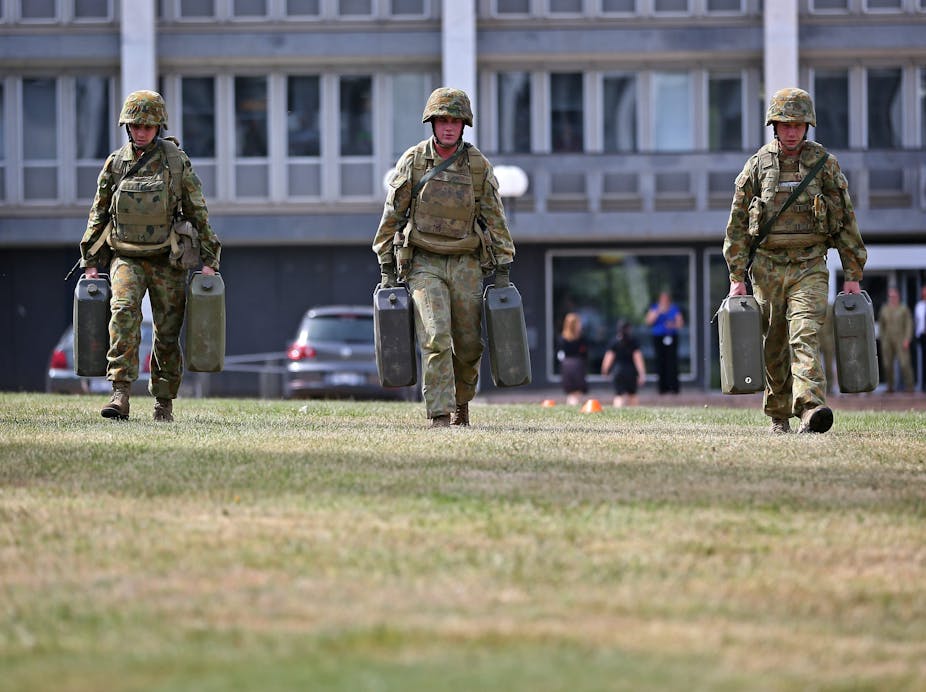Serving on operational deployments in conflict zones carries not only the obvious physical threats, it also poses significant mental health risks. While depression and anxiety disorders are common among returned service personnel, post-traumatic stress disorder (PTSD) is perhaps the most commonly considered mental disorder in this group.
Approximately 8% of Australian Defence Force (ADF) members report current PTSD, though the rates of PTSD following specific deployments have not yet been published.
A parliamentary committee is currently investigating this issue as part of its inquiry into the care of ADF personnel injured on operations. The release date of the final report hasn’t been confirmed, but so far submissions and public hearings have raised concerns about the risks of PTSD, disclosure of mental health problems and when it’s safe to redeploy soldiers who have experienced mental ill health.
What is PTSD?
PTSD is a potentially debilitating mental condition characterised by intrusive recollections of a traumatic event. This might include repetitive nightmares and distress when faced with sights and sounds that remind the person of the trauma. People with PTSD are constantly on guard and look for threatening situations, meaning they’re in a constant state of high physiological arousal.
Given the distress these trauma memories can evoke, survivors try hard to avoid thinking about them or coming into contact with related reminders, sometimes going to great lengths to move to more remote areas to stay away from possible cues. Avoidance can also take the form of emotional numbing, where the person with PTSD experiences an emotional “shutdown”, with difficulty feeling love or happiness.
Survivors also may use alcohol or other substances to dampen levels of anxiety and blot out the nightmares and distressing memories. Such substance abuse, combined with emotional numbing, can significantly affect relationships with partners, families and friends.

Risk to Australian soldiers
The years between the withdrawal of the last Australian soldier from Vietnam in 1973 and the conflict in East Timor in 1999 were relatively quiet for ADF members, with the exception of a number of briefer deployments in Cambodia (1991-93), Somalia (1992-95) and Rwanda (1994-5).
Over the past 13 years we’ve seen a significant change in the ADF’s “operational tempo”, with frequent military deployment to conflict zones. So it’s likely that as a serving member of the ADF – whether soldier, sailor or airman – you have been deployed to a conflict zone on at least one, and often more than one, occasion. These deployments vary quite significantly in the level of risk and conflict confronted.
Importantly, current research informs us that the risk for mental health problems does not rise with increased deployments per se. Rather, the risk of PTSD is determined by the frequency and severity of the potentially traumatic events to which serving members may be exposed on these deployments.
PTSD treatment
PTSD and other mental health problems that emerge in the context of deployment are treatable. We have very effective psychological and pharmacological treatments available, particularly if people can access these treatments early.
But serving members who experience these mental health problems on return from deployment face the dilemma about whether to step forward and report them to Defence medical personnel. Many ADF members, particularly in this heightened operational environment, are keen to be redeployed and fear that acknowledging a mental health problem will reduce their likelihood of being redeployed and will negatively affect their military career.
Of course, this is not a simple issue to address. The ADF has made significant efforts, particularly in recent years, to de-stigmatise mental health problems. It has tried to make clear to members that their psychological injuries will be regarded and treated the same as physical injuries: the aim is effective treatment followed by a rapid return to their military roles.
This task is made difficult in organisations such as defence forces, where globally and historically the culture has stigmatised people with mental health disorders. Such policy and culture changes take time to work their way through to the day-to-day experience of the serving member on the ground.

The desire to look after the interests of an ADF member with a mental health concern, however, must also be balanced against the need to protect the safety of this individual member and those with whom he or she may be deployed. Just as physical fitness to perform a role has to be assessed prior to deployment, a person’s mental fitness to perform a role must also be assessed.
As with physical injuries, there are decisions to be made about the degree to which the mental health problem may interfere with functioning, and limit the capacity of the member to respond to the kinds of scenarios faced on deployment.
Redeployment after mental illness
We know that a history of prior mental health problems is a risk factor for development of future mental health problems. However, making this a “rule out” for future deployment is a sure fire path to reducing self-disclosure and further stigmatising mental health.
And many members recover well from a transient mental health disorder, so any risks posed by their previous psychological injuries are minimised.
Redeployment decisions, therefore, need to be made on a case-by-case basis, with careful consideration of the nature of the person’s recovery and their future risk.
Over the years, the ADF has gained expertise in identifying psychological injury in its members and offering prompt treatment that in some cases allows the member to return to deployment if they wish.
Stigma around mental health still exists within the defence forces but this is slowly changing. Hopefully with time we can find a balance between protecting the safety of all members on deployment and encouraging open disclosure and acceptance of psychological injuries.

